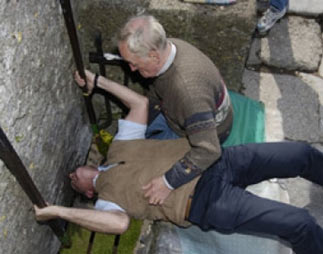Are you familiar with the 1960s TV game show, Let’s Make a Deal? The host, Monty Hall, would ask costumed contestants, known as trades, for an item and if they could divulge it, they had they had the opportunity to trade it for hidden prizes. Requested items could range from a safety pin to a plunger or yardstick. Contestants would bring everything they could think of, including the kitchen sink because they new knew what Monty might ask them to produce.
During the 19th century, rural doctors were general practitioners by necessity. They delivered babies, set broken limbs, pulled teeth, and tended to all sorts of wounds and diseases. Except in large metropolitan areas, few doctors had medical specialties. Similar to contestants on Let’s Make a Deal, rural physicians needed a variety of tools to be prepared for any situation.
Doctors traveled long distances on foot, on horseback, in wagons, buggies, ferries, canoes and boats. Traveling to a settlement might be a cross country journey on nothing more than an unmarked trail. The doctor’s bag was designed to carry the tools of the trade and withstand travel in all sorts of weather. Bags of durable oiled canvas or leather stood up to extended travel, whatever the season and terrain.
What might you find in the 19th century doctor’s bag?
A variety of tools for everything from pulling teeth to delivering a baby to amputate a limb might be found inside. A basic medical kit would include scalpels, tweezers, razors, and scissors. They would have carried catgut for suturing and gauze bandaging as well. If they were desperate, human or horse hair, or even fiddle strings would suffice when stitching up an injured patient.
Bullet probes and extractors were very important items. They looked like bent tongs or forceps. They came in various lengths to extract a bullet, depending where it was located in the body.
Other items in the bag might include a stethoscope, glass thermometer (3 inch mercury ones started around 1867; up until then they were longer at 6 inches, sometimes 12), splints for broken bones, vaginal specula, forceps for labor and delivery, and bloodletting instruments.
A frontier doctor would have also needed tools for general surgical procedures of the time.
This would include items such as tourniquets, knives and scalpels, and saws for amputation.
The use of antiseptics would not have been on the mind of these pioneer doctors. Although Louis Pasteur’s research provided solid evidence in support of the germ theory of disease, American physician’s clung to the older view that germs were spontaneously generated. The American Medical community also opposed Joseph Lister’s research indicating that the use of carbolic acid to clean medical and surgical instruments significantly decreased the rate of infection and mortality from surgery. Therefore American doctors took no care to clean their instruments, wear gloves, or fully seal wounds. In fact, drainage of “laudable pus” and inflammation were considered signs that a wound was healing properly.
Because the antiseptic technique was slow to be adopted in American hospitals, medical instruments continued to be manufactured with decorative etching, wooden or grooved handles, and velvet cases, like those pictured above, reflecting that hesitancy.
Doctors would have had a variety of painkillers at their disposal including laudanum, morphine and cocaine. For more on 19th century painkillers, see my post “Got Anything for the Pain, Doc?”
By 1850, most frontier doctors carried some basic anesthetics for use in extreme cases. Nitrous oxide, called Laughing Gas because of its euphoria inducing qualities, was first used as a dental anesthetic in 1844. Ether was used for general anesthesia starting in 1846, and chloroform in 1847. Chloroform anesthesia became very popular after it was administered to Queen Victoria in 1853 for childbirth.
Keeping up with the latest medical procedures would have been a high priority for rural doctors as well. The American Medical Association began in Philadelphia in 1847. Members received a quarterly newsletter announcing new methods of surgery, recent research, advice from prominent physicians on the East Coast or Europe.
Because of their dedication to their patients, frontier doctors were often the most well-known and most valued members of their communities. They likely delivered every child in the community and sat with the dying as they drew their last breath. They saw people into and out of this world, and in the meantime tried to keep them alive and healthy. Their selfless devotion to their patients and and creative ingenuity have left a legacy that continues to capture the imagination of the American people.









































